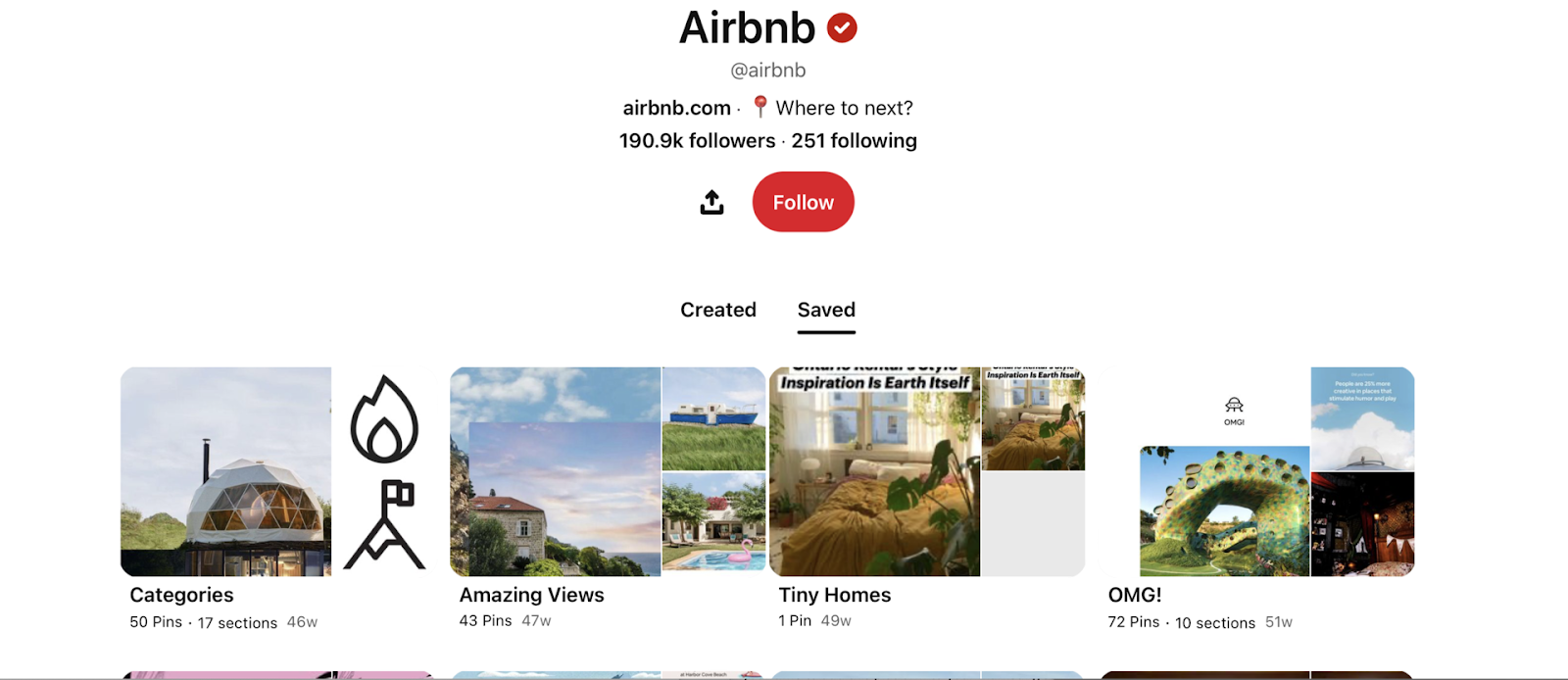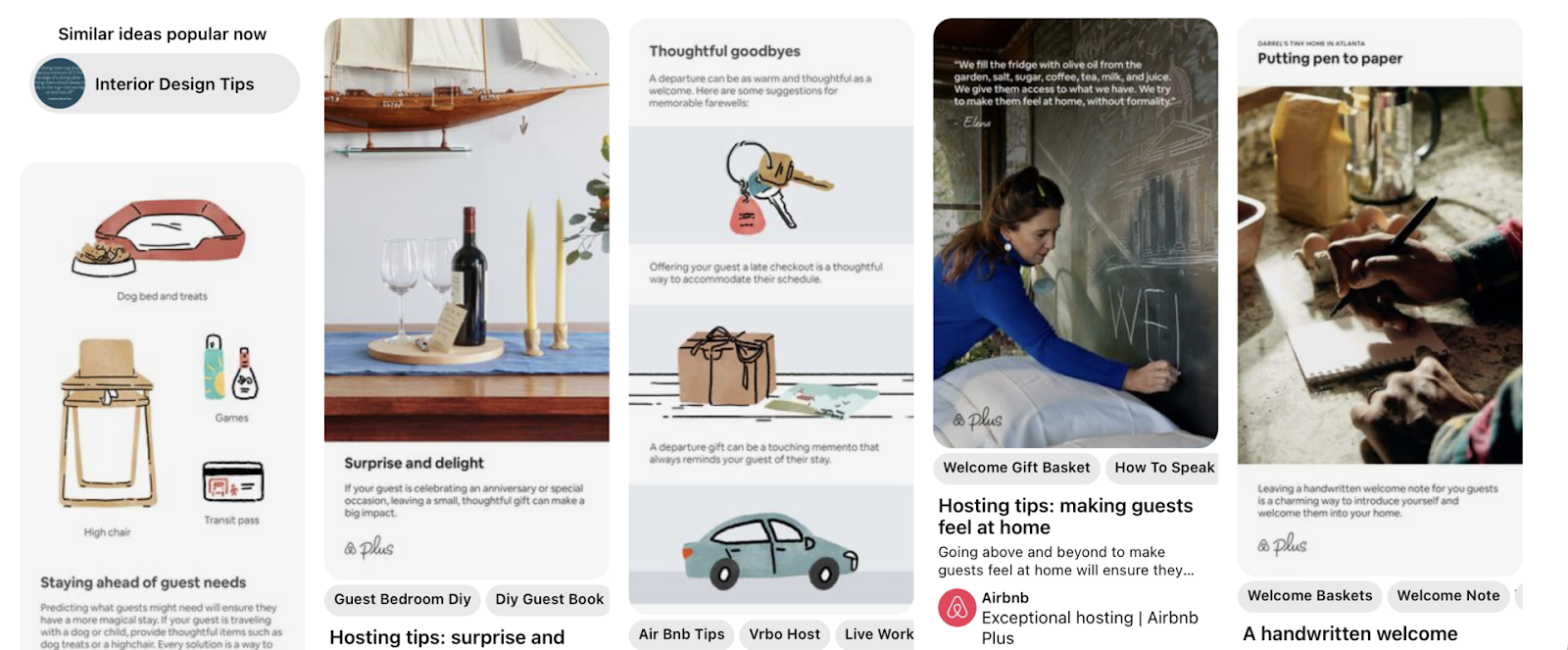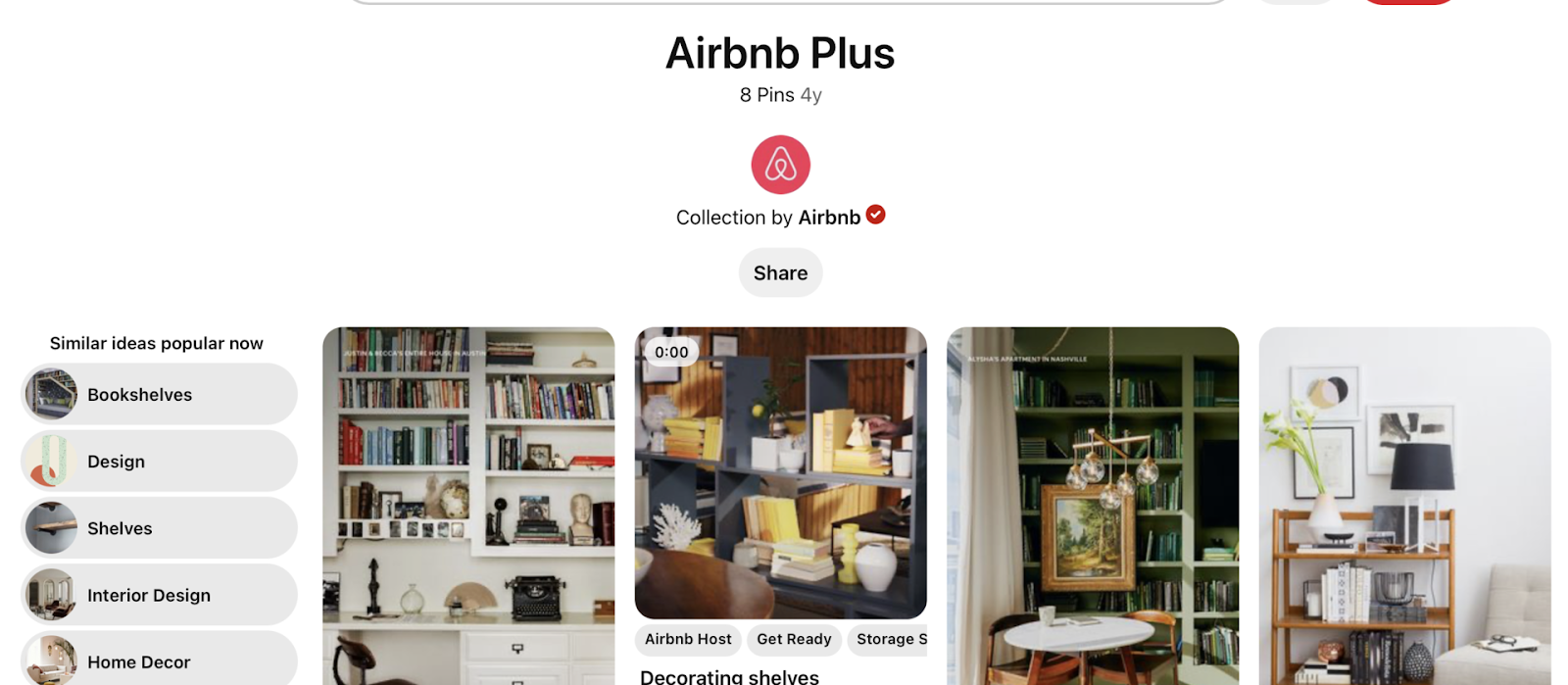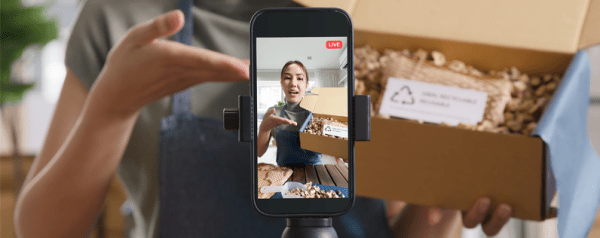
I travel all the time — in fact, I’m writing now from an Airbnb in Las Palmas de Gran Canaria in Spain. I picked this island for the vibrant community, warm winter weather, and — the options I saw when pursuing through Airbnb’s Pinterest page.
When it comes to using Pinterest for business, Airbnb nails it. They have boards for every kind of getaway you could dream of, from staying in a tiny house to tropical experiences to countryside escapes. Their Pins are inspirational for two audiences: people like me who love to travel and those who own Airbnbs and want to make their apartments and homes unique.

It’s easy to spend hours scrolling through all the ideas each business offers on Pinterest. You can say to yourself, “maybe I’d like to spend a night in a castle or on a sailboat!” and it hits on exactly why a Pinterest marketing campaign is worth including in the outreach plans for many small- and medium-sized businesses. Active users of this popular social media platform love to be inspired by visually appealing content.
There is great potential for your business through utilizing the Pinterest platform. To begin, set up a business account and develop a strategy for Pinterest. Next, check out these 10 tips to learn more ways to help your business get started on Pinterest. When business owners leverage the power of the Pinners — the users of this platform — they’ll be able to reach a larger audience and deepen their relationships with current customers.
The potential of Pinterest in business growth
Pinterest might not be the first platform you may think of when you develop a social media strategy, as it tends to rank behind Facebook and Instagram in popularity depending on the demographic; however, Pinterest boasts 465 million active accounts, making the platform a place where people within your target audience go to focus on creativity, new ideas, and inspiration.
It’s a site to go to when people want to improve their lives in some way — and by adding your products and services into the mix, you can meet that desire. Your business account can offer fresh ideas that add value to people’s lives rather than just being a source of clickbait.
According to Pinterest stats, the majority of Pinterest’s audience is female, at 60%, and more than a third of American millennials have an account. Plus, 45% of Pinners in the United States have household incomes above $100,000. So, perhaps it’s not surprising that 80% of weekly users discovered a new brand or product from Pins they saw.
Many people flock to Pinterest because the platform offers a breath of fresh air from the controversial opinions and “highlight reel” life updates that sometimes make other social media sites challenging to navigate. Pinterest is simply fun — and that’s where the potential for business growth comes in.
With a Pinterest for Business account, you can expand your brand to new audiences, funnel traffic to your website, and drive online sales. Share new products and services while connecting deeply with those who want to learn more about your values and vision.
How to craft your Pinterest business strategy
The first step to creating an effective Pinterest strategy is to brush up on how to craft impactful, sharable content for social media. For newbies, you’ll find this article on social media for beginners helpful. Remember that the best social media marketing plans are thoughtful and targeted. Before you make your first Pin, take the time to create a content calendar filled with topics that matter to your current and potential customers.
One way to get comfortable with Pinterest is to create a personal account first. You can sign up easily with an email account, through Facebook, or your Google account. The platform will ask you about your interests to create a homepage for you. It will continue to refine its suggestions as you make your own boards and Pins.
Identify your target audience
Understanding the user experience for yourself will be important as you begin to create your business’ Pinterest strategy. That’s because marketing on Pinterest — like all marketing strategies — must focus on your target audience’s wants, needs, and desires. Commonly, business owners will create outreach plans based on what they want their audience to know, but you should think of it as the other way around: what should your audience know about your business, products, and services?
Start by brainstorming a clear understanding of the target audience for your business. A good way to do this is by creating what’s known as a customer avatar. This exercise involves defining the demographic details of your ideal customer and then fleshing out the finer aspects of their lives. When you know their pain points, you’ll know how they want to be inspired by your product pins.
For example, the Airbnb site has an entire board filled with product pins about “exceptional hosting.” This clearly shows their work in understanding both of their important target audiences. When I arrived at my Airbnb in Gran Canaria, my host had a bowl of local fruit as a welcome gift. The plantains and mangos were delicious, and my loyalty to my host was sealed.

Optimize your Pinterest profile
Once you know who you want to check out your Pinterest profile, it’s time to optimize it. Start by keeping your social media names consistent — whatever you used for your Facebook for Business or Google Business profiles, use them here, too.
Then, as you write your short company bio, make sure to integrate keywords that your target audience will use to search for your goods or services. Bios on Pinterest must be less than 160 characters, so use clear and concise wording to demonstrate what makes you first, different, or better than the competition.
Don’t forget to add your website domain to your profile. This step allows you to track Pinterest analytics associated with Pinners, clicking through your boards and over to your website. Verifying your website to earn a checkmark next to your profile name is also a good idea. Finally, link your other social media accounts so users can switch between platforms if they wish.
Create relevant and engaging pins
With your target audience at the forefront of your mind, it’s time to get creative. The best Pinterest for Business tips that any marketing professional can offer are all based on the need for engaging, useful, and interesting Pins. Your profile is nothing without high-quality visual content.
Try using social media tools to help create a campaign of Pins. I love using Canva, a free graphic design software that offers a wide variety of professional templates. If it makes sense for your business, invest in professional photography to highlight some of your goods or services. Or create short videos, which you can edit within the app using Idea Pins. Add audio and tag businesses you are collaborating with.
Most importantly, have fun as you execute your Pinterest for Business plan. This is a visual social platform, so great designs and interesting topics are how to get your Pins seen.
Use boards effectively
Pinners are creative types, but they also tend to be an organized bunch. One of the most important of all Pinterest best practices is to have a tidy profile with your Pins categorized under clearly labeled boards.
Not only will this make your profile look more inviting, but boards will help Pinners find what they’re looking for more easily. For example, when I pop on Airbnb’s Pinterest page, I know if I’m interested in staying near a national park, a desert, or a tropical paradise. They’ve organized their boards so that I can jump straight to my desired experience without having to scroll through options that don’t interest me.
You can do your target audience the same favor by using your boards effectively. This will also make it more likely that people will post your Pins to their boards, which is basically free word-of-mouth advertising for your brand.
Incorporate keywords for discovery
As you create your boards and pins, don’t forget about the power of Pinterest SEO, or search engine optimization. Check your profile settings to make sure your page is visible to search engines, then incorporate the right keywords to get discovered in organic searches.
This will involve learning how to do keyword research. You can use the Pinterest tools to help, too. When you type a keyword into the Pinterest search bar, many additional phrases will pop up as suggestions. This can help you learn how people search for related items or services. Also, check out your competitor’s Pinterest for Business profiles to see their keywords.
Include keywords in the filename of your profile image. Organize your boards based on targeted keywords. The more strategic you are, the more it will pay off.
Benefits of using Pinterest for business
Pinners want to see fresh ideas, products, and services that inspire them to live their best lives — and your business can help, but only if you’ve got a Pinterest for Business account. As you create a social media marketing campaign for this platform, think about your long-term goals for the work.
When you have specific goals, you can break down the actions needed to achieve them with smaller, shorter-term objectives. The success of these objectives can be measured with metrics, many of which are available in the backend of your Pinterest for Business profile. Make a habit of looking at the data to see if you’re on track to meet those big goals you’ve set for your company’s success.
Increase brand awareness
One goal with which Pinterest can certainly help is the act of increasing your brand awareness. The more Pinners scroll your profile and share your Pins on their boards, the faster your audience will grow.
As more people learn about your brand, you have more opportunities to bring them into the beginning of a customer journey. Awareness is the first, and perhaps most important, step in the growth process.
Drive traffic to your website
You can track the number of Pins shared from your boards, but an even better metric is the number of clicks from Pinterest to your website. This is the next step in the customer journey, and it’s worth having as a goal. The more people who visit your website, the more likely you’ll make a sale.
One powerful way to do this is through content marketing. If you haven’t already, consider starting a blog for your business. Write on topics that help to position you as an authority in your industry. You can use Pinterest to post links to your blog posts through Promoted Pins.
Then, use call-to-action buttons and links to make it easy for these potential customers to click from the blog directly to your website.
Generate leads and sales
You can track the number of Pinners who go from Pinterest to your website, but again, that’s still not as important to your bottom line as generating sales. A common goal of many marketing campaigns is to increase your number of leads and sales.
To measure your Pinterest profile’s impact on sales, ask your customers where they first heard of your business in a short survey.
Promote your products or services
Another benefit of Pinterest for Business is the ability to highlight specific products or services with Pins. This is an excellent objective that drives bigger goals for your company, so use this platform’s opportunity to showcase new and innovative offerings in visually appealing ways.
For example, Airbnb has a board dedicated to inspiration for styling a bookcase for Airbnb owners. While this targets owners, it attracts me as a traveler, too. When owners put the extra effort into good design, they’ll likely take care of other touches like extra pillows, a vase of flowers, or maps of the area.

Build a community of followers
At its heart, marketing is a way to deepen relationships with your current and future customers. When Pinners discover your brand on Pinterest and enjoy your visual content, they will come to appreciate the work you do. They’ll see your tone and style, and they will take the time to learn about your vision and values. In the end, they become a part of a community you are creating online.
Tracking followers is a great metric, but don’t just focus on the numbers. Interact with your followers by following them, checking out their boards, and seeing what interests them. You’ll find that by understanding this target audience, you can connect better — and gain more sales as a result.
Get started on Pinterest and reap the benefits for your business
Now that you know all the benefits a Pinterest account can bring your business, it’s time to get creative! Start with your personal Pinterest account as a first step. Using what you know already about your target audience, start searching as if you are your customer avatar.When you get an idea of what’s out there, you may find yourself inspired — to embark on a new campaign to help you achieve your biggest business goals. While you’re at it, continue to grow your business’s social media presence on other platforms — these social media tools are here to help.




